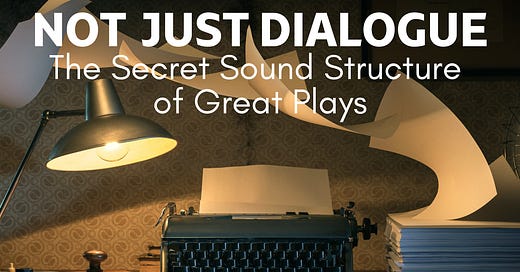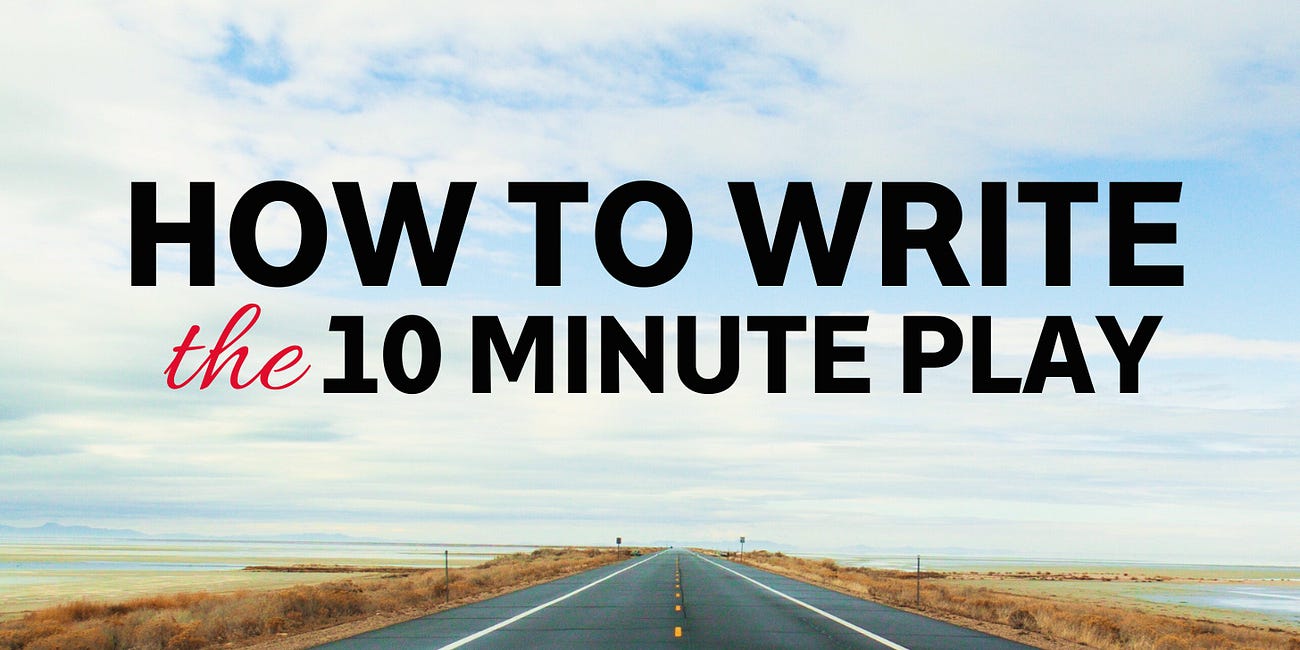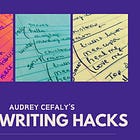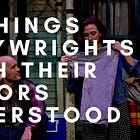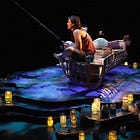One of these days, I’ll finish my book on the hypnotic elements of stage plays. Until then, I’ll keep banging this drum:
Most theater playwriting classes focus on fundamentals like structure, character development, dialogue, conflict, and scene work. Poetry isn't usually emphasized unless the instructor has a literary background or you're studying writers known for their lyrical style, such as Sarah Kane, Suzan-Lori Parks, Lorca, or Caryl Churchill. Occasionally, classes will touch on poetic elements in monologues or stylized dialogue, but it's rarely a central focus in standard curricula.
However, when poetry is included, it can be transformative. Some courses will explore rhythm and meter in dialogue, the use of repetition and pattern, symbolic language and image systems, or the power of white space and silence. These techniques are especially relevant in experimental or hybrid forms of theater, and in MFA programs that value interdisciplinary approaches. While not always taught outright, poetry often functions as the hidden engine behind the most emotionally resonant and memorable theatrical writing.
In Suzan-Lori Parks’ Topdog/Underdog, for example, the rhythm of Booth’s monologue isn’t just about bravado. It’s about what’s cracking beneath it. The pause lands harder than the punchline. The silence tells the truth.
What Is It That We're Really Building?
Some plays are built around plot. Others are structured around sound, rhythm, and breath. In these works, the architecture isn’t just what happens, but how it moves through the body. The language isn’t ornamental. It’s functional. It carries emotional weight in a way that bypasses logic and goes straight to the nervous system.
One approach to this kind of writing is composing with the ear in mind. The cadence of speech, especially in regional or vernacular dialects, becomes a tool for trance. Scansion—the patterning of stressed and unstressed syllables—can elevate everyday speech into ritual. In Southern stories (my wheelhouse), the rhythms of conversation already carry a kind of music. When shaped with care, they become incantatory. Not lyrical for its own sake, but closer to spoken prayer. Something that invites the audience to stop thinking and start absorbing with their breath.
You can feel this in Tarell Alvin McCraney’s The Brothers Size, where speech becomes invocation and the line between dialogue and ceremony disappears.
Silence in this context is not a pause between ideas. It’s the emotional floorplan. The spaces between words are often where the story actually lives. In grief-centered plays, especially, silence becomes sacred. It holds the weight that characters cannot name. Beats and pauses become mirrors for trauma. What is left unsaid often lands louder than anything that gets spoken aloud. And it’s rarely because the characters don’t know the truth. It’s because saying it might destroy them. So the silence is where the fight happens. Where memory flickers. Where the audience, too, starts to shift in their seats, recognizing the shape of a wound they didn’t expect to see mirrored back.
You see this masterfully in Annie Baker’s The Flick, where a line as plain as “I don’t know” floats in a space thick with everything not being said.
Reading the Score
Italics
Even something as small as italics can carry serious dramaturgical weight. Used sparingly and with intent, italicized words in a script don’t just indicate emphasis. They’re emotional cues. They show the actor where the energy spikes, where a word is breaking through a wall, or where it’s being swallowed. A single italicized phrase can sometimes suggest the shape of an entire backstory. These little markers guide the performance toward something more alive, less literal. They point to the tremor under the line.
Repetition
What looks like plain speech on the page often contains a whole sonic structure beneath it. The phrasing may:
Loop: “I don’t know, I mean—I don’t know, okay?”
Circle back: “You said you were fine. And then later, you said it again.”
Contradict itself: “I love her. I mean—I hate her. I don’t know what I mean.”
Return with a different tilt: “It’s nothing. Really. It’s just… it’s not nothing.”
These are not mistakes or hesitations. They’re part of a larger pattern. Repetition is often used to soften resistance, to create space for the audience to feel before they think. This kind of structure doesn’t call attention to itself. But it creates openings. It allows the audience to slip sideways into memory, grief, or recognition. There’s something spiritual in it. Not religious necessarily, but invitational. The language becomes a kind of threshold. A quiet passage.
Silence
In certain plays, the text functions more like a musical score than a literary object. The rhythm leads the heart before it ever reaches the brain. The silence holds equal footing with the dialogue. The shape of the line matters. The spacing matters. And when it works, the audience doesn't just follow a story. They move through something. They breathe differently. They arrive somewhere they didn't expect.
This is the kind of architecture that holds not just character and plot, but emotional gravity. It doesn't shout. It doesn't explain. It hums. It waits. It listens back.
BONUS: Open Loops
Some lines don’t close. They trail off, get interrupted, or hang in the air. These open loops create tension. The audience leans in, waiting for completion that never comes. It’s a form of invitation…and a form of grief. What’s missing becomes the point.
“I was going to tell you but—”
“If you had just—”
“Never mind.”
Open loops are one of the most underused tools in stage plays. You might know them by other names: foreshadowing, suspense, withholding. But their power isn’t just emotional—it’s neurological. The brain holds onto unresolved threads:
The real estate traveled between the moment a loop is opened and the moment it’s closed is where the listener’s attention sharpens. Memory imprints more clearly. Investment deepens. They’re not just listening anymore. They’re leaning forward.
And it’s not just about lines. Sometimes a visual element—a coat never worn, a door never opened, a mirror draped in cloth—can function like a line left hanging. These objects hum with unfinished business. They’re silent carriers of tension, waiting to speak. A loop isn’t always something said. Sometimes it’s just something placed. And left alone. Until it isn’t.
If we want our plays to truly land, we have to start listening to the language under the language. That’s where the pulse is.
PAID SUBSCRIBERS GET A FREE MONTHLY STICKER!
YES, I POST SUBMISSION OPPS
https://audreycefaly.substack.com/t/submissions (bookmark this page)
PREVIOUS ARTICLES BY AUDREY CEFALY
How to Write the 10-Minute Play
This year I had the pleasure of mentoring a few dozen writers in preparation for submission to Concord Theatricals Off Off Broadway Short Play Festival. I thought I would summarize some of the advice I gave to these aspiring writers. I’d also love to hear about any techniques that work for you; feel free to comment below.
LEAN MORE ABOUT AUDREY
Visit my website for more about me and the work I do!
Audrey Cefaly's plays (Alabaster, Maytag Virgin, The Gulf, The Last Wide Open, Trouble) have garnered the Lammy Award, the Calicchio Prize, the NNPN Goldman Prize, the Edgerton, and a Pulitzer nomination. Her works have been produced at Signature Theatre, Cincinnati Playhouse, Barter Theatre, Merrimack Rep, Florida Studio, Florida Rep, Gulfshore Playhouse, and countless others. Cefaly is a Dramatist Guild Foundation "Traveling Master," an Arena Stage playwright cohort, and a recipient of the Walter E. Dakin Fellowship from the Sewanee Writers Conference. She is published by Concord Theatricals, Applause Books, Smith & Kraus and TRW.


